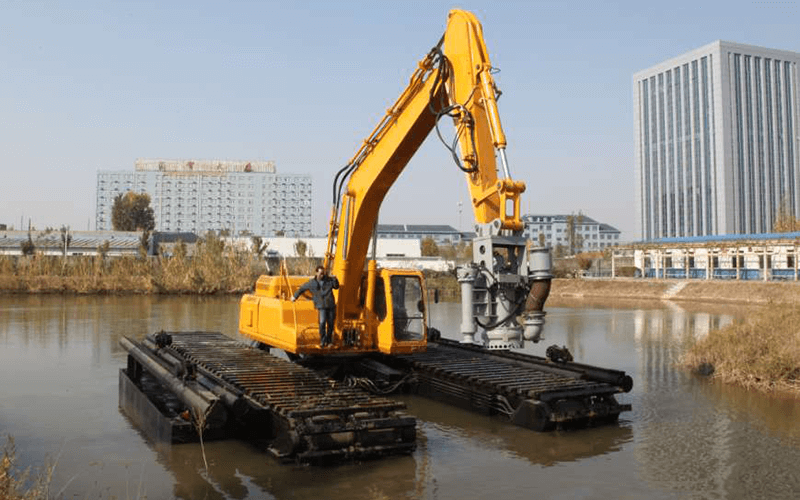When working in waterlogged environments like wetlands, swamps, and rivers, traditional construction equipment often falls short in terms of efficiency and accessibility. Amphibious excavators have revolutionized the way such projects are handled, providing a versatile solution that can operate both on land and water. Whether it’s for environmental restoration or dredging operations, these machines are becoming indispensable tools in various industries.
What is an Amphibious Excavator?
Amphibious excavators are specialized construction machines designed to operate in environments where the ground is soft, unstable, or submerged in water. Unlike standard excavators that struggle on waterlogged terrain, amphibious excavators are fitted with pontoons or floating tracks that enable them to move effortlessly through muddy, swampy, or shallow water areas.
These excavators are equipped with long-reach booms, which allow operators to access hard-to-reach areas without needing to move the machine frequently. Their floating ability, combined with their robust structure, makes them ideal for tasks such as dredging, environmental cleanup, and wetland restoration.
Primary Applications of Amphibious Excavators
Amphibious excavators are becoming increasingly popular across various industries due to their versatility. Below are some of the primary areas where they are widely used:
- Wetland Restoration: Wetlands are fragile ecosystems that play a crucial role in environmental sustainability. Amphibious excavators are used to clear invasive vegetation, reshape the land, and restore the natural flow of water. Their ability to operate in shallow waters makes them the perfect tool for this delicate work.
- Dredging Projects: Dredging is essential for maintaining water channels, removing sediments, and improving water flow. Amphibious excavators can efficiently perform dredging tasks in areas where traditional dredging boats may not be able to reach due to shallow water levels.
- Coastal Protection: Amphibious excavators are commonly used in coastal regions to build levees, repair damaged shorelines, and prevent erosion. These machines allow construction teams to reinforce coastal structures even in challenging waterlogged terrains.
- Oil and Gas Exploration: In oil and gas fields located in swampy areas, amphibious excavators are used to install pipelines, maintain infrastructure, and carry out drilling operations. Their ability to navigate through marshy environments makes them indispensable for operations in these regions.
Safety Tips for Operating an Amphibious Excavator
Operating an amphibious excavator requires proper training and adherence to safety protocols to ensure smooth and accident-free operations. Here are some critical safety tips:
- Assess the Terrain: Although amphibious excavators can float, it’s essential to analyze the depth, consistency, and type of waterlogged terrain you’ll be working in. This assessment ensures that the machine won’t encounter obstacles or unstable areas that could compromise its performance.
- Regular Maintenance: Like all heavy machinery, amphibious excavators require regular inspections and maintenance. Ensure that the pontoons, tracks, and flotation devices are in optimal condition before beginning any project.
- Specialized Training: Operators should undergo specialized training to handle amphibious excavators, as the operating conditions differ from those of standard construction vehicles. Training should include navigating waterlogged areas, understanding weight distribution, and mastering the machine’s controls.
- Monitor Weather Conditions: In areas prone to heavy rain or flooding, water levels can rise quickly. It’s crucial to keep an eye on weather forecasts and adjust operations accordingly to ensure the safety of both the operator and the equipment.
Conclusion
Amphibious excavators have transformed how construction and environmental projects are managed in waterlogged environments. Their ability to operate efficiently in both land and water makes them a valuable asset in various industries. From wetland restoration to coastal protection, these versatile machines continue to make complex projects more manageable, while reducing environmental impact. If you’re working on a project that involves challenging terrain, an amphibious excavator may be just the solution you need.
FAQs
- Can amphibious excavators operate in deep water?
Amphibious excavators are designed to work in shallow waters, usually up to 1.5 meters deep. For deeper water operations, additional flotation devices or specialized equipment may be necessary.
- What industries benefit the most from using amphibious excavators?
Industries such as environmental restoration, oil and gas exploration, dredging, and coastal protection benefit greatly from amphibious excavators due to their adaptability to challenging, waterlogged terrains.
- Are amphibious excavators environmentally friendly?
Yes, they reduce the need for constructing temporary infrastructure, which minimizes damage to sensitive ecosystems like wetlands and coastal areas.
- Can a traditional excavator be converted into an amphibious one?
Some traditional excavators can be modified with pontoons or other flotation devices to make them amphibious. However, it’s important to consult with experts to determine the feasibility and safety of such modifications.

